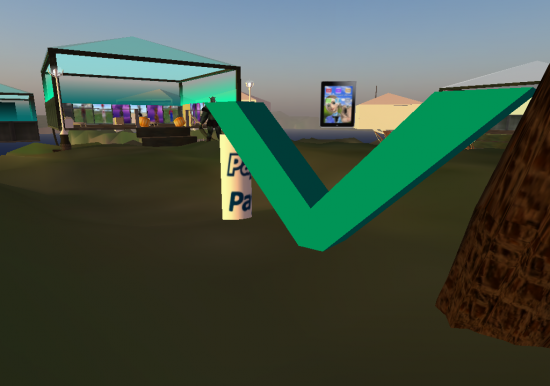Virtual worlds run by non-profit organizations focus on providing a low-cost platform for other non-profits and individuals. To many in the non-profit sector, in-world economies belong on for-profit grids like Second Life and Blue Mars.
However, some non-profits running grids on the OpenSim platform are beginning to embrace in-grid payments for donation boxes, land rentals, and even small retail shops.
The non-profit FrancoGrid, for example, has recently joined other grids on the OMC virtual currency standard, which works with the standard browser payment function in a way similar to Second Life, but is secure enough to use with hypergrid teleports.

For Paris-based musician Reynald Melloni of the band The Reymones, the new payment options means that he will be able to have a tip jar at his next concert. He will be performing at the Virtual Worlds Barcamp conference on FrancoGrid this weekend.
According to Fabrice Parisi, FrancoGrid co-founder, the grid is chartered as a non-profit, and an in-world currency is a thorny issue for grid participants. Today, the grid allows OMC and PayPal payments, but only for limited uses.
“You can use it for donations,” he said. “But not to sell virtual items.”
OMC is a multi-grid currency that works with hypergrid teleports — you can go shopping on several different grids and bring your purchases back to your home grid, with a single payment account. Today, seven grids support OMC payments from Austrian virtual currency company Virwox — FrancoGrid, YourAlternateLife, Avatar Hangout, Grid4Us, GermanGrid, OpenNeuland, and WilderWesten.
Other non-profit grids, such as OSGrid, have no grid-wide currency but allow individual members to set up PayPal or PayPal Micropayment donation boxes or sales terminals. ReactionGrid, a for-profit grid that typically servers education and corporate clients, recently also rolled out PayPal payment support.
“It’s not that important for commerce to happen in a non-profit area,” said Caleb Booker, an analyst at UK-based virtual worlds research firm Clever Zebra. “But if they want to be able to accept donations, or hire workers for small job, it makes sense to have currencies in the world where work is being done.”
There are three main ways to implement payments on a grid.
One is to install a grid-wide currency system, using the optional OpenSim currency module, and centrally administer the payments and the money supply. Some of the large private social grids, like InWorldz, have in-world currency systems that are limited to their own grid.
The PayPal option involves installing a module that processes the PayPal payments into the server software that runs individual regions. Region owners can also implement PayPal payments without the module, by using having an in-world object open up the PayPal payments page. The modules add extra functionality to the basic PayPal setup, such as guaranteed delivery of items. Final payment approval takes place on the Web, however, to take advantage of the encryption and additional security available through a website.

OMC payments require that a grid be registered with Virwox, explained FrancoGrid’s Parisi. Virwox then provides a module unique to the grid which allow interaction with their payment system. The module is installed directly into the individual regions that will be offering Virwox sales terminals or account access kiosks. Unlike PayPal, the OMC currency is integrated with the browser. For users and merchants, the currency looks and acts the same way that Linden dollars do in Second Life — the browser shows the current balance, and merchants are able to use the standard object payment interface. Since it’s a multi-grid system, users can access their OMC accounts on multiple grids — the same way they can make payments from their own PayPal account on multiple websites.
When deciding which currency platform to go with, Clever Zebra’s Booker recommends that users evaluate how important it is to keep costs low, and how important it is to have a high degree of security.
PayPal, for example, is the most secure of the payment options, he said, but is also pricy.
“There’s always going to be an issue of transaction fees and a lack of control with PayPal,” he said.
New currency platforms like Virwox, need to become more transparent, he said.
“They need to make public information easily accessible about what the real-world people are who are involved,” he said. “We’ve had some really bad experiences over the past five years with pseudo-companies. It wasn’t about them being dishonest — that was them getting in over their heads.”
Booker was referring to in-world “banks” and “stock exchanges” in Second Life and other virtual worlds that were founded by avatars and not backed by real-world business entities — and suffered a series of runs, crashes, and embezzlement.
OpenSim-based currencies seem to have taken some of those lessons to heart.
Virwox, for example, is a service of Austria-based Virtual World Services Gmbh, and the website lists a phone number and an email contact, as well as its business registration number — but doesn’t provide any additional details about the people behind the company, or the guarantees they offer to their currency users.
The OMC currency currently has around 200 registered users and 250,000 OMC (US $900) in circulation.
Another option for multi-grid payments, CyberCoinBank‘s G$, is not redeemable by the issuer, but can also be traded with other users. This adds additional security concerns, but could be appropriate for some grids.
“It’s not a great basis for virtual currency in worlds as we understand them,” said Booker. “But it’s a great basis for virtual currencies in a game.”
- OSgrid back online after extended maintenance - April 16, 2025
- Analysts predict drop in headset sales this year - March 25, 2025
- OSgrid enters immediate long-term maintenance - March 5, 2025
